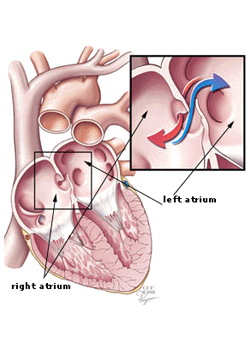A patent foramen ovale (PFO) is a hole in the heart that didn’t close the way it should after birth. During fetal development, a small flap-like opening — the foramen ovale (foh-RAY-mun oh-VAY-lee) — is usually present between the right and left upper chambers of the heart. It normally closes within the first or second year of life. When the foramen ovale doesn’t close, it’s called a patent foramen ovale. With each heart beat or when a person with this defect creates pressure inside his or her chest – such as when coughing, sneezing, or straining during a bowel movement – the flap can open, and blood can flow in either direction directly between the right and left atrium. When blood moves directly from the right atrium to the left atrium, this blood bypasses the filtering system of the lungs (the lungs actually do dissolve tiny blood clots). If debris is present in the blood, such as small blood clots, it now passes through the left atrium and can lodge in the brain, causing a stroke, or another organ, such as the heart, eyes, or kidneys.
Patent Foreman Ovale Closure

